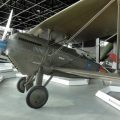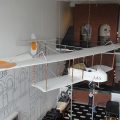Den SPAD S.XIII was a French biplane fighter aircraft of the First World War, developed by Société Pour L’Aviation et ses Dérivés (SPAD) from the earlier and highly successful SPAD S.VII.
During early 1917, the French designer Louis Béchereau, spurred by the approaching obsolescence of the S.VII, decided to develop two new fighter aircraft, the S.XII and the S.XIII, both utilizing a powerful new geared version of the successful Hispano-Suiza 8A engine. The cannon armament of the S.XII was unpopular with most pilots, but the S.XIII proved to be one of the most capable fighters of the war, as well as one of the most-produced, with 8,472 built and orders for around 10,000 more cancelled at the Armistice
Kilde: SPAD S.XIII på Wikipedia
Flere opplysninger:
Den SPAD S.XIII was a French biplane fighter aircraft of World War I, developed by Société Pour L’Aviation et ses Dérivés (SPAD) from the earlier highly successful SPAD S.VII. It was one of the most capable fighters of the war, and one of the most-produced, with 8,472 built and orders for around 10,000 more cancelled at the armistice.
The SPAD S.XIII differed from its predecessor by having a more powerful engine, a twin Vickers machine gun armament, and a slightly larger wingspan. The new engine gave the aircraft a better speed and climb rate, making it a match for the latest German fighters. The twin guns increased the firepower and reliability, as the single gun on the S.VII often jammed. The larger wingspan improved the handling and stability, but also increased the weight and reduced the agility.
The SPAD S.XIII was flown by many famous aces, both French and Allied, such as Georges Guynemer, René Fonck, Charles Nungesser, Eddie Rickenbacker, and Francesco Baracca. It was also used by several air forces after the war, including Belgium, Brazil, Czechoslovakia, Finland, Greece, Japan, Poland, Portugal, Romania, Siam, Spain, and Yugoslavia. It remained in service until the late 1920s.












